What heats better? Which heating batteries are better for an apartment, prices of devices
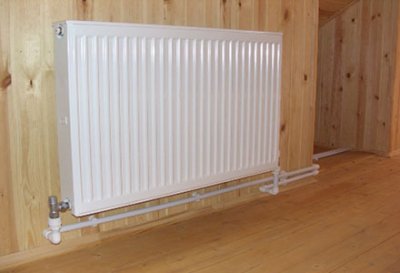
It is important for home owners to have as many things in their home as possible were not only functional, but also had a pleasant appearance.
The choice of heating system for a room usually stops at radiators.
They are relatively easy to install and operate, do not require large financial and energy costs, and quickly heat the air in the room, and the aesthetic properties and varieties finally convince the buyer to choose radiator heating.
Content
Types of radiators, their price
There are several types of radiators for heating systems, which differ in the material they are made from.
When is it wiser to choose cast iron?
There is an opinion that all bad radiators are necessarily made of thick and heavy cast iron. Of course, this is not true: cast iron heating systems are used as creative author's solutions and reliable sources of heat in the room.
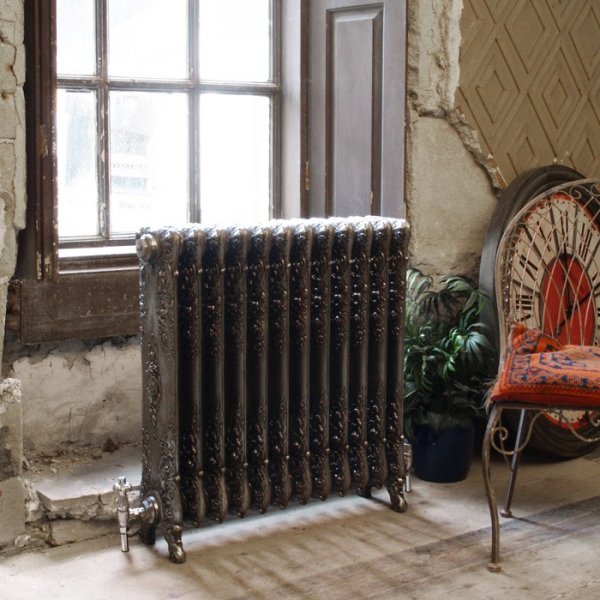
Photo 1. Cast iron heating radiator with decorative forging. The device is installed on the floor.
Design
Batteries of this type consist of oblong sections, each of which is divided into two parts. These components are cast from metal in factory molds, after which these halves are fastened and sealed, leaving only holes for the flow of coolant.
Typically, batteries have different numbers of cells, so differ in power: The more cells, the faster the air in the room heats up. These components of the radiator are connected to each other by welded seams and several holes for water circulation inside.
Pros and cons
Advantages of cast iron radiators:
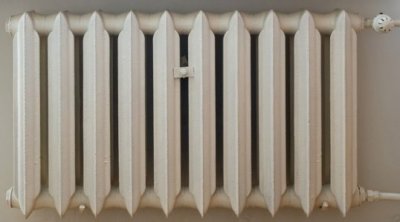
- Regardless of how many times the water is drained from the cast iron battery and what its quality is, a corrosion layer does not form inside, because Cast iron is highly resistant to corrosion processes.
- Resistance to water hammer. Thick walls allow water to be supplied to the system under very high pressure, which is why they are often used in central heating systems.
- Durability and reliability. The batteries will last for decades.
- If you heat the metal well, then it will continue to give off heat for a very long time even after the coolant supply has stopped.
Disadvantages of the radiator:
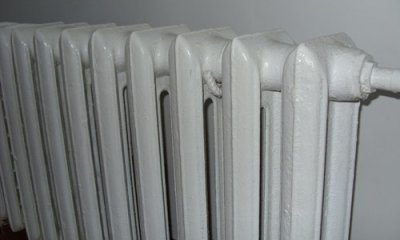
- Enormous weight Compared to other types of radiators, cast iron batteries are difficult to transport and install.
- Each section typically requires about a liter of coolant. - is of great importance for other heating systems.
- To properly heat the walls of the battery, it is necessary to maintain constant circulation of hot water for a long time.
System characteristics and service life
The average weight of one radiator section is from 4 to 7 kilograms, working pressure — 9 atmospheres, heat transfer power — from 0.050 kW to 0.20 kW per section. Sizes may vary depending on the manufacturer.
Attention! Large batteries are mounted only on special hooks or brackets, as their weight reaches 100-150 kilograms.
As experience with such radiators shows, they can be installed once for a lifetime, and then only periodically serviced. This is the most durable type of heating of all those present on the market. The cost of one section of the radiator varies from 1200 to 2500 rubles. For a ready-made retro radiator made of cast iron you will have to pay a colo 6-8 thousand rubles.
Aluminum
Such batteries do not torment the eyes with an unpleasant appearance, they heat the room well, weigh relatively little And are still in the budget price range.
Design
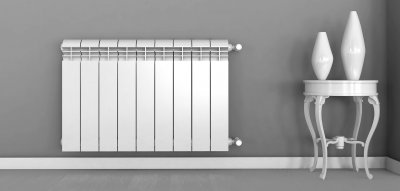
Such radiators are manufactured using three methods:
- Casting: Each section is made from a mixture of aluminum and silicon. After hardening, they are connected with nipples, and for the flow of water, the water supply channels are sealed.
- Pressing: The required number of parts are squeezed out of the metal mass using a press, which are then joined together again thanks to it.
Important! Constructions of this type are non-collapsible, it is not possible to add additional sections.
- Anodized: 98% Aluminum undergoes a chemical process called anodizing, after which the metal acquires resistance to corrosion, increased heat transfer and high strength.
Pros and cons
Advantages of aluminum radiators:
- Lightweight yet durable.
- It takes no more than this to heat up the entire battery. 10-20 minutes.
- Average section volume — 300-400 mm.
- Additional heat dissipation is provided by convectors.
- Reasonable price.
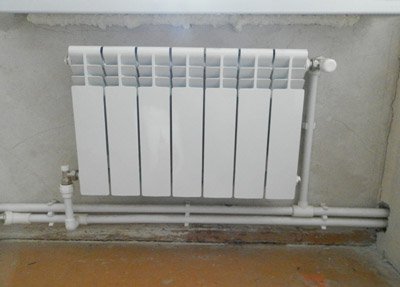
Disadvantages of radiators:
- The batteries cool down quickly.
- Connections are a weak point of aluminum systems; frequent leaks are possible.
- Service guarantee - up to 15 years; only a few manufacturers confirm that their device will last longer: 20-25 years old.
- Metal is subject to corrosion processes. Anodized models are protected from this, but their cost is higher.
- Sensitivity to water hammer.
System characteristics and service life
Average weight of one part - 1.5—2 kg. Working pressure 12-30 atmospheres. Heat dissipation - from 0.09 to 0.23 kW. Section price ~ 400-1000 rubles, anodized models - 1.5-2 times higher.
Steel: where is it better to put them?
A common heating solution for private homes and commercial premises.
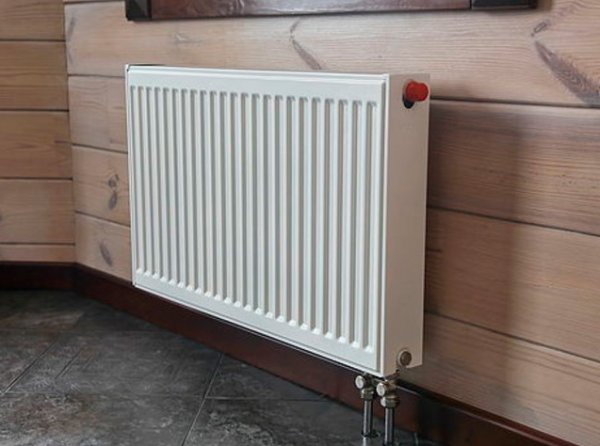
Photo 2. Steel panel heating radiator. The device is fixed to the wall, heating pipes are connected from below.
The main distinguishing feature is low consumption of liquid coolant And very fast heat transfer from the battery to the walls, and from them - into the air.
Reference. The system becomes maximally efficient if you purchase radiators with convectors for each panel: 22 or 33 type.
Design
Steel (otherwise known as panel) radiators are assembled from several pre-fabricated panels. Each panel is two fastened sheets of thin steel, onto which grooves for water circulation have been applied using a press. The maximum number of panels in one battery is 3.
Pros and cons
Advantages of radiators:
- Fastest heating among all systems with liquid coolant.
- So light that they can be installed and lifted up and down the floors one person can do it.
- Low hot water consumption.
- Effective energy consumption of the heating boiler and pump: hot water streams quickly release heat and are immediately replaced by new ones, without stagnating in the channels.
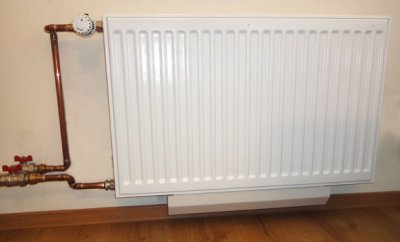
Disadvantages of radiators:
- If the coolant supply is stopped, the walls cool down instantly.
- The metal is subject to corrosion when using unfiltered water and frequent exposure to air.
- Sensitivity to water hammer.
System characteristics and service life
Power: from 1.5 to 1.8 kW. Weight: medium radiator 22-type weighs ~ 7 kilograms. Price: ~ 5 thousand rubles for a type 11 device and 15-17 thousand rubles for a type 33 device. Service life: 15-25 years. Working pressure — 6-10 atmospheres.
Important! Most steel batteries cannot be used in apartments, since they are not able to withstand the pressure of the municipal heating network.
Bimetallic batteries
Hybrid heating option. They are perfect for heating any room due to their power and pleasant appearance.
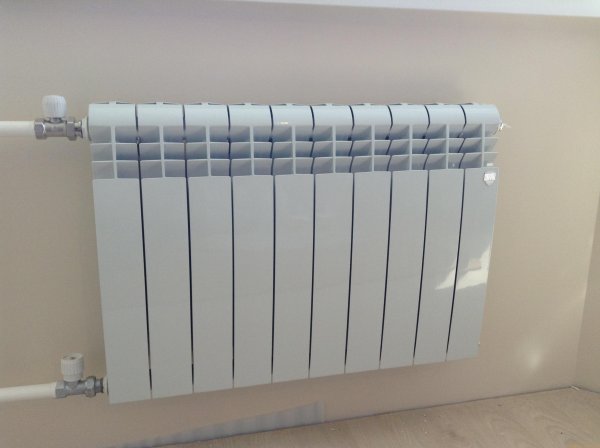
Photo 3. Bimetallic heating battery. The product consists of ten sections, the number of which can be increased or decreased.
Design
Cast steel pipes are placed in thin aluminum cases, so bimetallic radiators can be difficult to distinguish from solid aluminum ones. This design solution allows for the rapid transfer of heat from hot water to the aluminum walls, and then into the room. As a rule, it is produced with nipples between sections - If necessary, some parts can be removed or added.
Pros and cons
Advantages:
- Service life.
- Steel core protects the entire radiator from corrosion (there is a special protective coating) and water hammer.
- Heat from water is transferred almost instantly to the steel rod and from it just as quickly - onto the sheets of the aluminum box.
- Modern look, environmental friendliness and ease of cleaning are ensured by the use of an anti-corrosion coating on the outer walls of the battery.
Flaws:
- Relatively high cost.
System characteristics and service life
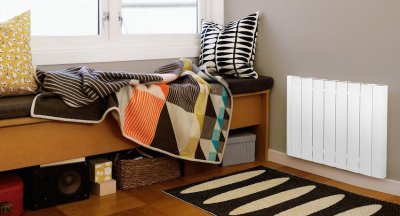
Power: from 0.09 to 0.20 kW. Average volume and weight of one section — 0.2 liters, 1.2 kilograms.
Maximum withstand pressure: 20-40 atm.
Radiator on 10 sections will cost the homeowner 8-12 thousand rubles, but it will last ~ 30 years.
Copper is a good option for country houses
Often used in country houses, garages and cottages. Type of copper convector perfect for loft or grunge style interiors.
Reference. Both hot water and steam can be used as a heat carrier in copper radiators.
Design
One or more steel pipes are bent into a zigzag shape, after which these pipes are pierced with copper plates, which greatly improve heat transfer due to convection. The number of pipes and the number of plates in the convector determines the power of the device. Sometimes, for greater heat transfer and better safety, the radiator is placed in a steel casing that fits into any interior.
Pros and cons
Advantages:
- Light weight — a copper heater can be mounted even on plasterboard walls.
- Excellent thermal conductivity and, accordingly, a good value for the power level.
- One of the most pleasant aesthetic sets in various technical and design solutions.
- Water hammer resistance (but over time copper stretches, which reduces its service life) and the ability to withstand high pressure.
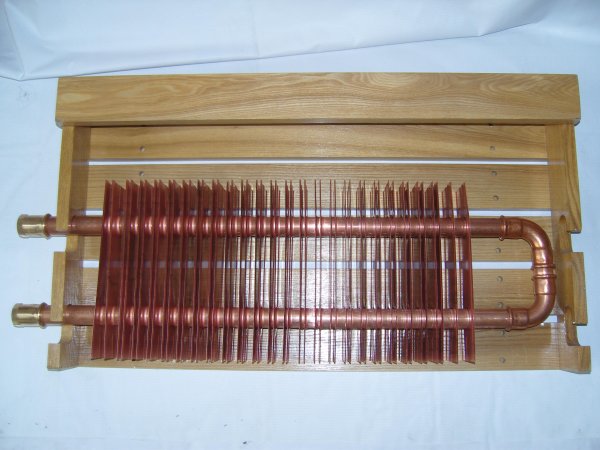
Photo 4. Copper heating radiator. Consists of a tube through which many copper plates pass.
Flaws:
- Copper practically does not tolerate proximity to other metals., therefore copper-steel or copper-aluminum radiators quickly deteriorate.
- High cost of quality products.
System characteristics and service life
Working pressure 12-18 atmospheres. Maximum coolant temperature — 150 °C. Power: average 0.30 kW. The cost of a copper radiator will be approximately 11-13 thousand rubles, and the service life is 30-40 years old subject to operating instructions and careful handling.
Plastic
The most budget-friendly option. The characteristics of plastic cannot be compared with metal and alloys, so the use of plastic radiators is justified only by economic considerations.
Design
The plastic mass is pressed using a hammer and molds. Then steel pipes are placed inside to circulate the water. Additional sections cannot be added., since everything is hermetically sealed.
Pros and cons
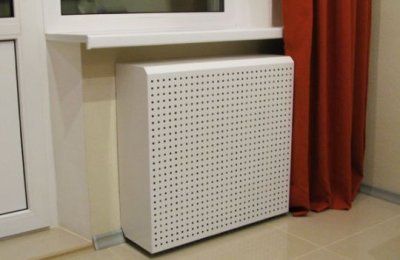
Advantages:
- Low cost.
- Light weight.
Flaws:
- very low power;
- poor thermal conductivity;
- fragility of the material;
- sensitivity to pressure surges and high levels.
With proper care, the service life will be 5-10 years. Price 3-4 thousand rubles.
Electrical
In essence, this is an ordinary electric heater, but slightly larger in size. It can be used both in a house and in an apartment, but is most often used in dedicated dry areas: attic, veranda, loggia.
Design and characteristics
In terms of design, an electric heating system is a set of heating elements, plates and convectors that transfer heat to the surrounding space. Advantages:
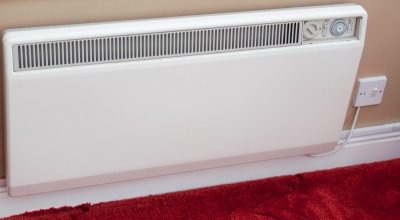
- Instant heating and start of heating the air in the room.
- Quick temperature regulation with a switch.
- Small size and weight.
- Pleasant appearance.
- Lack of coolant inside the radiator.
The disadvantages include constant electricity consumption., which can be a big hit to the budget if the homeowner lives in an area with expensive electricity. There is also a risk of short circuits and fires, but this is minimized thanks to quality control in production. The power of an average radiator: about 1.5 kW. Price — 4-5 thousand rubles with a service life of 3-5 years.
What are the best for central heating in an apartment
An important condition when choosing a radiator is ttechnical and design components: heating networks in a house and a communal apartment give different pressure values. Autonomous (private house) - do not give more pressure 10 atm., and in the pipes of a communal apartment - 16 atm.
Important! In communal apartments, pressure drops often occur - water hammer, which damage the heating system; in autonomous networks this happens rarely.
For an apartment (central heating) it is better to purchase: cast iron, aluminum and bimetallic radiators, as they can withstand high pressure and its fluctuations well.
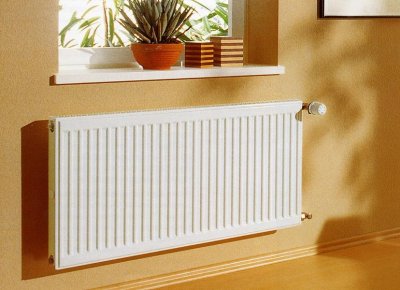
In addition, copper or steel (panel) radiators are suitable for an apartment, but they are more sensitive to water hammer.
For a private house (autonomous network) You can choose any radiator, but since the pressure in the network is not so high, the best solution would be a steel, aluminum or copper radiator.
An electric heating system is suitable for any room with a normal humidity level.
Useful video
Watch the video to learn how to choose the right heating radiator.
How to keep warm for a long time
A properly installed heating system - regardless of the type - will work for decades if all measures and precautions are observed, specified in the operating manual. But the main step is a thoughtful choice of radiators, taking into account the size and type of the room, the heating system and the characteristics of the product. For a guarantee, it is better to consult with the sellers in the store.









Comments